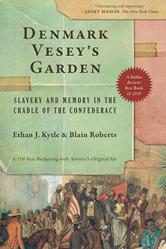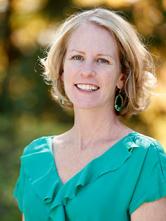AUTHOR SPOTLIGHT: Ethan J. Kytle and Blain Roberts
In an era when debates rage over how to treat Civil War monuments and address our country’s racist past, this new book narrows the focus to the epicenter of slavery in the United States: Charleston, South Carolina. Bryan Stevenson, whose own work on historical memory is made tangible with a new museum and memorial remarks that Ethan J. Kytle and Blain Roberts’s “meticulous research, compelling writing, and thoughtful analysis are vital to our nation at a time when we are haunted by a history we need to understand more deeply.” Examining public rituals, controversial monuments, and competing musical traditions, Denmark Vesey’s Garden tracks two rival memories from the Civil War to recent decades—when a segregated tourism industry reflecting opposing visions of the past took hold in Charleston, South Carolina.
New Press publicist Jessica Yu sat down with Kytle and Roberts to learn more about the hidden dimension of America’s hidden deep racial divide.
The story of how you came to write this book together is really interesting. Can you tell us what sparked the book?
Kytle/Roberts: The book can be traced back to a visit that we made in 2015 to Charleston, South Carolina—the capital of American slavery and today a mecca of historical tourism—just before we relocated to the city for new history positions. One June morning, we made a quick scouting trip to Charleston to look for a place to live.
The first apartment on our list turned out to be in a beautiful antebellum home flanked by spacious verandas and white columns. As we toured the basement apartment, which had been updated with gleaming granite countertops and custom window treatments, we made small talk with the owner of the building. We asked her about the home’s construction and its previous owners.
Like many Charlestonians who spend their days surrounded by relics of the past, our prospective landlady had done her research—sort of. The house had been built around 1840 by the Toomers, a wealthy family that included two physicians. Up until the Civil War, she informed us, the apartment we were considering had been the workspace of the servants. “Of the slaves,” one of us instinctively replied. The home owner again insisted they were servants. “There’s no evidence in the historical records,” she explained, “that the Toomers didn’t pay them.” It was quite a double negative. As we suspected that day and later confirmed, enslaved people had in fact lived and worked in the household.
The apartment, in the end, wasn’t for us. We found a more ramshackle unit and a landlord that were better fits. But the exchange that June day proved pivotal. Even though we moved to California after only two years in Charleston, we spent the next decade exploring how white residents like the owner of the Toomer house could be so oblivious to the role of slavery in their city’s history.
Our book ultimately results from our experiences in Charleston—from the fact that many of the white Charlestonians we encountered did not want to acknowledge slavery at all, and from the fact that when they did, they often mischaracterized it as benign, even beneficial.
We call this the whitewashed memory of slavery, and it dates back to the end of the Civil War. Standing in opposition to this tradition of remembering—or perhaps more accurately, forgetting—is an unvarnished memory of slavery. Forged by former slaves, their descendants, and some white allies, the unvarnished tradition recognizes and commemorates slavery as a brutal, inhumane institution. Our book traces the 150-year battle between these two competing memories.
Who was Denmark Vesey?
Kytle/Roberts: Denmark Vesey was Charleston’s most famous—and, to some, infamous—black revolutionary. The mastermind behind a failed 1822 slave uprising, Vesey was a black carpenter and former slave who had purchased his freedom with winnings from a city lottery but was unable to do the same for his family members. Frustrated that he could not liberate his family and unwilling to live under the repressive white supremacist regime in Charleston, Vesey and his co-conspirators, many of whom were members of the recently established African Church, plotted a large-scale insurrection to take place on July 14, Bastille Day.
But the rebellion was foiled before it could be carried out. Ultimately, local authorities executed Vesey and thirty-four co-conspirators and sold a similar number, including one of Vesey’s sons, outside the United States. The Vesey affair sent shock waves across the South, and it prompted Charleston to crack down on its African American population by tearing down the African Church, curtailing the few liberties afforded free blacks, and tightening slave supervision.
Our book, we should add, is not a biography of Denmark Vesey or a close examination of his insurrection. Instead, it is a history of the memory of slavery in Charleston—a memory in which Vesey has figured prominently.
We titled our book Denmark Vesey’s Garden to gesture at the central argument of the book, which is that from 1865 to the present, Charlestonians—white and black, rich and poor, native-born and newcomer—have forged two competing visions of slavery, the whitewashed and the unvarnished. No Charleston figure better epitomizes the unvarnished memory than Denmark Vesey—a free black man who was tortured and died in an effort to burst the chains of the city’s enslaved. And no term better captures the whitewashed memory of slavery than “garden”—the euphemism that Charleston boosters used to market historic plantations to the tourist throngs who descended upon the city throughout the twentieth century and who continue to do so today. In fact, to many of these folks—native Charlestonians and visitors alike—the entire city is a garden paradise.
Once we finished writing, we came to see how much Vesey really haunts the book. That’s because he has really haunted the city since his death, hovering like a ghost as white Charlestonians attempted to downplay the centrality of slavery to their history. Their ability to minimize slavery has waned in more recent years, however, as champions of the unvarnished tradition have succeeded in resurrecting and publicizing more truthful memories of the institution. Fittingly, these local activists erected a statue of Vesey in a public park in 2014.
Our title, in other words, is both a metaphorical ode to the book’s central theme and a literal reference to the changing state of affairs in Charleston. As we observe at the end of the book, Denmark Vesey now, in fact, stands watch over his garden.
We should also add that several years ago we read a New Yorker essay written by the novelist Jamaica Kincaid that inspired us to start thinking about the politics of race and gardens. We discuss the piece—and Kincaid’s own trip to Charleston—in the book’s conclusion.
You finished researching in the summer of 2015, at the same time that Dylann Roof killed nine churchgoers at Emanuel AME. How did that inform your writing and your vision for how this book would be received?
Kytle/Roberts: Yes, we were, coincidentally, in Charleston on June 17, 2015, the day of the Emanuel massacre, on one of our final research trips. That morning, about nine hours before the murders, we met with then mayor Joe Riley to get his thoughts on the strides Charleston had made in coming to terms with its painful slave past.
Riley was rightfully proud that Charleston had made progress on this front during his forty-year tenure in office. He was especially pleased that the International African American Museum the city was working to build might soon be a reality. We left the meeting feeling somewhat hopeful ourselves, since from our own personal experiences, and our decade of research, it did seem as though the history that Charleston was presenting to the public was much better—much less whitewashed—than it had been.
The following morning, we awoke to the news of Dylann Roof’s horrific rampage, which, not coincidentally, had taken place at Mother Emanuel—the latter-day incarnation of Denmark Vesey’s African Church.
As we struggled to understand Roof’s unimaginable actions, and learned more about him over the next few days and weeks, the optimism we had felt that morning faded. Roof was a Confederate flag waving devotee of the whitewashed memory of slavery—he claimed that slavery had not been that bad, and that allegedly false stories of how cruelly slaves were treated are today being used to justify a black “takeover” of the United States.
We were well aware that certain memories of the past can have nefarious consequences in the present—this was, after all, part of our motivation for writing the book. But to see this truth proven in such a heinous, devastating way—with the murder of nine African Americans—left us wondering about the efficacy of correcting a flawed understanding of the past. Roof, after all, had in the months before the murders toured Charleston’s historic sites, including McLeod Plantation, perhaps the best site to visit for an honest, unvarnished account of slavery. Yet these trips did nothing to change Roof’s historical misconceptions.
Still, in the three years since Emanuel, we’ve been heartened to see that this tragedy has sparked a new national conversation about our collective memory of slavery and, especially, the prominent place of Confederate flags and symbols in American culture today.
We see our book as a primer for this conversation, for Charleston residents have been debating these issues for the past century and a half. Denmark Vesey’s Garden, in other words, provides historical context for our contemporary divide over, and discussion of, the memory of slavery. Since the Civil War, Charleston has been teaching us how—and how not—to remember and memorialize this nation’s original sin.



